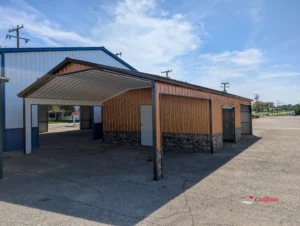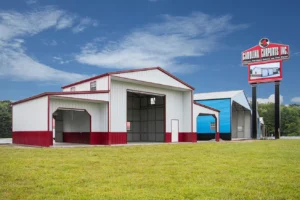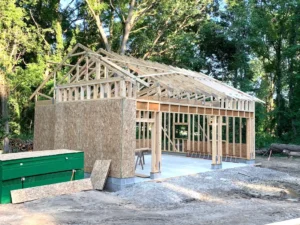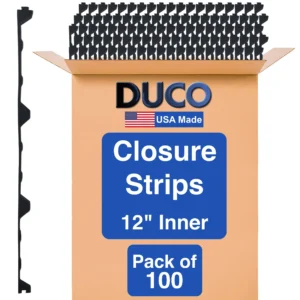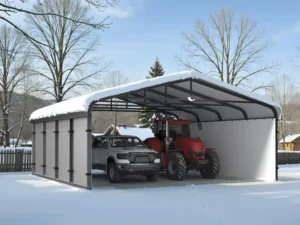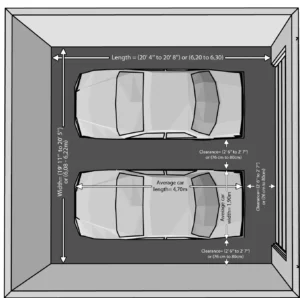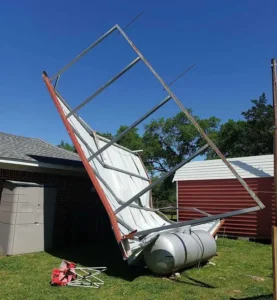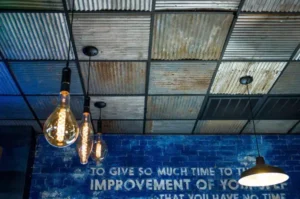6 Minute Read
75 Hardest Woods Ranked: Why Metal Might be the Better Choice
When it comes to building durable structures like garages, sheds, or carports, the type of material you choose matters. Wood has long been a popular choice, but not all woods are created equal. The Janka hardness scale measures a wood’s resistance to wear and denting, making it a key factor in determining which types of wood are best suited for construction.
In this article, we’ll explore the 75 hardest woods ranked by the Janka scale and discuss their common uses in construction. But we’ll also take it a step further: we’ll show you why metal structures—like the ones we specialize in at The Carport Co.—are often a smarter, more durable, and cost-effective choice for your next project.
Get Started
It’s quick and easy! Get a quote for an engineer stamped carport or metal building!

Manufactured in the United States

Competitive Warranties

Licensed and Insured Installers

Outstanding Customer Service
Structures That Stand Strong™
Table of Contents

What is the Janka Hardness Scale
The Janka hardness test measures a wood’s resistance to dents, wear, and tear by calculating the force (in pounds-force, or lbf) required to embed a steel ball halfway into its surface. The higher the Janka rating, the harder the wood.
But here’s the catch: Even the hardest woods can’t escape nature. Moisture causes rot, insects crave cellulose, and UV rays fade finishes.
💡 Steel’s “Janka Rating”:
- No rot, pests, or warping.
- Withstands 170 mph winds & 50 lbs/sqft snow loads.
- Zero maintenance. Zero headaches.
Top 5 Hardest Woods and their Limitations
Here’s a quick look at the top 10 hardest woods, how they’re commonly used, and their limitations compared to steel:
Australian Buloke (5,060 lbf)
- Uses: Flooring, tool handles.
- Steel Advantage: Buloke requires frequent oiling; steel carports never need staining.
Schinopsis spp. (4,570 lbf)
- Uses: Decking, railroad ties.
- Steel Advantage: Steel won’t splinter or crack in freezing temps.
Ipe (3,684 lbf)
- Uses: Outdoor furniture, docks.
- Steel Advantage: Ipe fades to silver without sealant; steel stays rust-free for decades.
Cumaru (3,540 lbf)
- Uses: Heavy construction.
- Steel Advantage: Termites ignore steel but devour Cumaru.
Brazilian Ebony (3,692 lbf)
- Uses: Luxury flooring.
- Steel Advantage: Ebony costs $25/sqft; steel structures are 50% cheaper over 20 years.
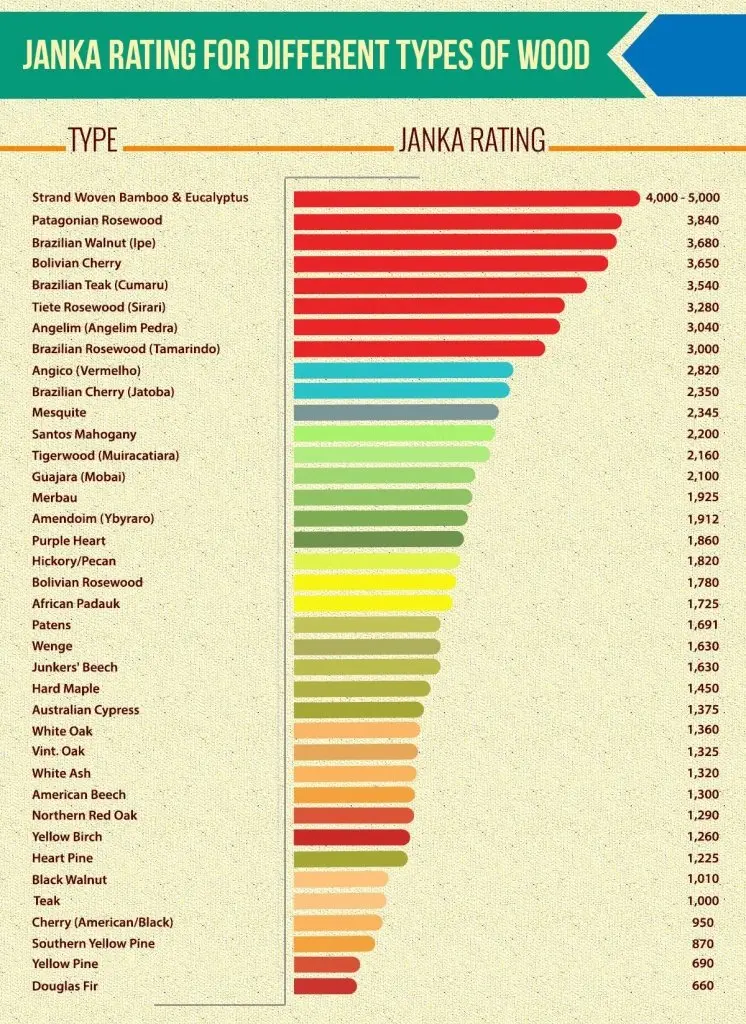
Top 10 Most Commonly Used U.S. Woods for DIY Carports & Garages
While exotic hardwoods dominate the Janka rankings, most Americans use cheaper, more accessible woods for DIY projects. Here’s why even popular choices fall short vs. steel:
Southern Yellow Pine (870 lbf)
- Uses: Framing, pole barns.
- Steel Advantage: Prone to rot and pine beetles; steel won’t decay or attract pests.
Douglas Fir (660 lbf)
- Uses: Beams, roofing.
- Steel Advantage: Warps in humidity; steel stays straight in any climate.
Cedar (900 lbf)
- Uses: Fencing, outdoor structures.
- Steel Advantage: Cedar fades and cracks without yearly sealing; steel requires zero upkeep.
Redwood (450 lbf)
- Uses: Decks, pergolas.
- Steel Advantage: Redwood is expensive ($15+/sqft) and soft; steel is dent-resistant and affordable.
Spruce (540 lbf)
- Uses: Sheds, temporary shelters.
- Steel Advantage: Spruce splits under heavy snow; steel handles 20 lbs/sqft loads.
Oak (1,360 lbf)
- Uses: Furniture, flooring.
- Steel Advantage: Oak is heavy and hard to work with; steel structures assemble in hours.
Hemlock (500 lbf)
- Uses: Basic framing, rustic builds.
- Steel Advantage: Hemlock rots quickly in rain; galvanized steel is 100% waterproof.
Pressure-Treated Pine (700–950 lbf)
- Uses: Decks, foundations.
- Steel Advantage: Toxic chemicals leach over time; steel is eco-friendly and safe.
Plywood (Varies)
- Uses: Sheathing, walls.
- Steel Advantage: Plywood delaminates in moisture; steel panels are seamless and weatherproof.
Poplar (540 lbf)
- Uses: Interior framing, paint-grade projects.
- Steel Advantage: Too soft for outdoor use; steel thrives in sun, rain, and snow.
75 Hardest Woods on the Janka Scale—Ranked From Hardest to Softest
Top 5 Reasons Homeowners Regret Choosing Wood
“I’m Always Staining or Repairing”
Steel structures don’t fade, rot, or attract pests.“My Pole Barn Warped After One Winter”
Galvanized steel stays straight in -30°F to 120°F.“Termites Destroyed My Shed”
Steel is 100% pest-proof.“Insurance Costs Skyrocketed”
Fire-resistant steel lowers premiums.“I Had to Replace It After 10 Years”
Steel outlives wood 3:1.

Steel vs Wood: Side-by-Side Comparison
Factor | Wood | Galvanized Steel |
Durability | Rot, termites | Immune to pests, rust, and rot |
Maintenance | Annual sealing/staining | None required |
Lifespan | 10-25 years | 40+ years |
Cost Over 20 Years | $15,000+ (repairs + labor) | $8,000 (one-time investment) |
Customization | Limited spans | Clear spans up to 60' wide |
Why Choose Metal Over Wood for Your Next Project
While hardwoods are impressive, they come with significant drawbacks—especially for large structures like garages, carports, or storage buildings. Here’s why metal structures are often the better choice:
1. Durability
Metal structures are resistant to rot, pests, and weather damage, making them far more durable than even the hardest woods.
2. Low Maintenance
Unlike wood, metal doesn’t require regular sealing, staining, or painting. A simple rinse with water is often all that’s needed to keep it looking like new.
3. Cost-Effective
Metal structures are typically more affordable than high-quality hardwoods, especially when you factor in long-term maintenance costs.
4. Customizable
At The Carport Co., we offer fully customizable metal structures in a variety of sizes, styles, and colors to match your needs and preferences.
5. Quick Installation
Metal structures can be installed in just a few days, compared to the weeks or months it might take to build a wooden structure.
Why Choose The Carport Co.?
At The Carport Co., we’re committed to providing carports and metal buildings that are not only affordable but also built to last. Here’s why our customers trust us:
FREE Delivery and Installation: We handle the entire process, so you don’t have to worry about a thing.
Nationwide Coverage: We serve the majority of the United States, bringing durable carports to your doorstep (or driveway).
Premium Materials: Our metal buildings are made from prefabricated tube steel (galvanized steel), available in both 14-gauge and 12-gauge for added strength and durability.
Expert Guidance: Our team is here to help you every step of the way, from choosing the right structure to installation.
Frequently Asked Questions
Is wood or metal better for a garage?
Metal is generally the better choice for garages due to its durability, low maintenance, and resistance to pests and weather damage.
How long does a metal structure last compared to wood?
Metal structures can last 50+ years with minimal maintenance, while wood structures typically require significant upkeep and may need to be replaced sooner.
Can metal structures be customized?
Yes! At The Carport Co., we offer a wide range of customization options, including size, style, and color.
Can steel buildings withstand hurricanes?
Yes! Our steel structures are engineer rated for 170 MPH hurricane winds and meet strict coastal building codes.
Is steel eco-friendly?
Yes! Steel is 100% recyclable. Wood contributes to deforestation and landfill waste.
Does galvanized steel rust?
Galvanized steel has a zinc coating that prevents rust, even in coastal areas.
What is the strongest wood on the Janka scale?
Australian Buloke (5,060 lbf). But remember: hardness ≠ weather resistance!
Table of Contents
Ready to Begin Your Project?
Do you think The Carport Co. would be a good fit for you? We’d love to earn your business. Fill out the quote form, and one of our friendly representatives will be in touch with you shortly. We’re here to answer questions you may have, provide personalized recommendations, and get you an estimate on your project.
To speak with someone, call (888) 293-5588 or email [email protected].
Don’t miss out on the opportunity to enhance your property with a durable, versatile, and visually appealing metal structure. Contact The Carport Co. today and experience what we can do.
Visit our 3D Builder to design your own structure!
Get Your FREE Custom Quote
No-obligation, 100% FREE quote, delivered in minutes.
The Ultimate Buyer’s Guide is a collection of articles by The Carport Co. These articles have been catered to first time steel and metal carport, garage, and commercial building buyers. Our goal is to share as much information with customers as possible, to help make informed decisions, and ensure a customer doesn’t discover an addition they would have liked to added at the time of sale, but was not aware of the option’s existence.
Here is a preview of a few articles. To view the full Buyer’s Guide, please visit the Ultimate Buyer’s Guide page.
